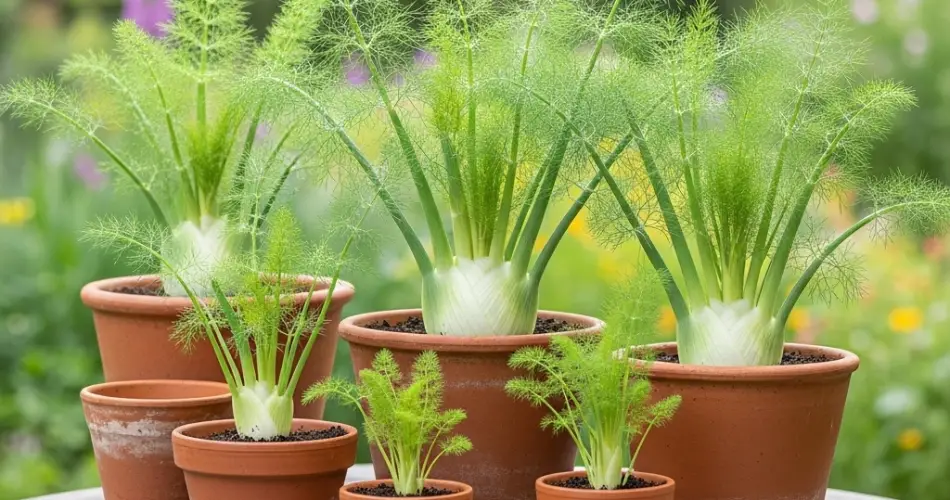Fennel is a versatile herb and vegetable known for its aromatic, licorice-scented fronds and crisp, flavorful bulbs. Widely used in Mediterranean and Asian cuisine, it’s a fantastic plant to grow in home gardens—even in small spaces. While often thought of as a garden bed plant, fennel grows surprisingly well in pots, offering gardeners with limited space a chance to enjoy this fragrant and tasty crop.
Whether you’re after the feathery leaves for garnishing and teas or the bulb for cooking, growing fennel in containers is both achievable and rewarding. With the right setup and care, you can enjoy fresh fennel right from your patio, balcony, or sunny windowsill.
Why Grow Fennel in Pots?
Fennel may look delicate, but it’s a hardy and adaptable plant. When grown in containers, it allows for easy management of soil conditions, pest control, and placement. For those without a backyard, container gardening opens the door to cultivating this flavorful herb right at home.
Benefits of growing fennel in pots include:
-
Controlled soil moisture and drainage
-
Flexibility to move the plant for optimal sun exposure
-
Less competition from weeds
-
Suitable for patios, balconies, and windowsills
-
Aesthetic appeal from its delicate, fern-like fronds
Choosing the Right Fennel Variety
There are two main types of fennel you can grow:
-
Florence fennel (bulb fennel) – Grown for its crisp, edible bulb and used widely in cooking.
-
Common or herb fennel – Grown mainly for its feathery leaves and aromatic seeds.
If you’re focused on growing edible bulbs, choose Florence fennel. If you’re more interested in harvesting leaves and seeds for teas or spice blends, herb fennel may be more suitable.
Selecting a Container
Fennel has a long taproot and needs a deep container to develop properly. Use a pot that’s at least 30 cm (12 inches) deep and wide. A wider container allows more airflow around the plant and helps prevent fungal diseases, especially in humid climates.
Make sure your container has good drainage holes to prevent root rot. Clay pots are ideal for airflow, but plastic containers also work as long as they drain well.
Soil and Planting Tips
Fennel prefers loose, well-draining soil that’s rich in organic matter. Use a high-quality potting mix amended with compost or aged manure. Adding a bit of perlite or coarse sand improves drainage and aeration.
The ideal pH range is between 6.0 and 7.0. Avoid heavy, clayey soils, which retain too much moisture and limit root development.
To plant fennel:
-
Sow seeds directly into the container, about 1 cm deep.
-
Space seeds about 10–15 cm apart.
-
Keep the soil consistently moist until germination, which usually takes 7–10 days.
-
Thin seedlings as they grow, leaving the strongest plants with adequate space to develop bulbs.
You can also transplant seedlings into your pot, but fennel prefers to be grown from seed due to its sensitive taproot.
Light and Temperature Needs
Fennel is a sun-loving plant and grows best with 6 to 8 hours of direct sunlight per day. Place your container in a sunny spot—such as a south-facing balcony or patio.
It prefers cool weather but can tolerate warm temperatures. Ideal daytime temperatures range from 15°C to 24°C (59°F to 75°F). In very hot climates, provide some afternoon shade to prevent bolting (premature flowering).
Watering and Feeding
Fennel needs consistently moist soil, especially while the bulb is forming. Water regularly, ensuring the top few centimeters of soil don’t dry out completely. However, avoid overwatering—too much moisture can cause root rot.
Feed your fennel plant every 3–4 weeks with a balanced liquid fertilizer. During the bulbing stage, switch to a low-nitrogen fertilizer to promote root development instead of leafy growth.
Encouraging Strong Bulb Growth
If growing Florence fennel for bulbs, it’s essential to “hill up” the base as the bulb starts to swell. Once the bulb is visible above the soil, gently mound extra potting mix around its base to protect it from sunlight and help it stay white and tender.
Avoid disturbing the roots during this stage, as fennel doesn’t transplant well once established.
Harvesting Fronds and Bulbs
-
Fronds: Begin harvesting the feathery leaves once the plant is 30 cm tall. Snip small amounts from the top, avoiding heavy cuts that might affect growth.
-
Bulbs: When the bulb is about the size of a tennis ball (around 7–10 cm in diameter), use a sharp knife to cut it at the soil level. Harvest before the plant bolts and sends up a flowering stalk.
-
Seeds: If allowed to flower, fennel produces aromatic seeds that can be harvested when dry and brown.
Common Growing Issues
-
Bolting: Fennel is prone to bolting in hot weather. Keep soil moist and provide partial shade in extreme heat.
-
Pests: Aphids or caterpillars may occasionally appear. Spray them off with water or use natural remedies like neem oil.
-
Yellowing leaves: Often a sign of water stress—either too much or too little. Adjust your watering schedule accordingly.
Conclusion
Fennel is a flavorful, beautiful, and highly rewarding plant to grow in containers. Whether you’re harvesting the fronds for garnish or waiting patiently for a plump, crisp bulb, fennel thrives with a little care and the right setup. With this guide, even beginners can grow strong, healthy fennel in pots—turning small spaces into a fresh and fragrant herb garden.



